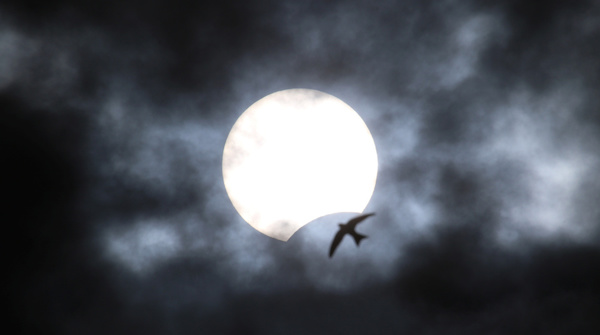
A partial solar eclipse is seen from Yevpatoria, Crimea, Russia, on June 21, 2020. (Photo by Reuters)
A partial solar eclipse has been seen in the skies of Africa all the way to China, including in Iran, on the first day of summer (June 21).
Sky gazers witnessed the most dramatic annular solar eclipse - known as a "ring of fire" because of the bright ring of sunlight it draws around the moon - on Sunday.
The relatively rare phenomenon of the alignment of the earth, the moon, and the sun lasted only a brief period, ranging in duration between a few seconds to several minutes in each location.
Because even The Sun can have bad days. But an amazing view for humans. Formation of the Ring of Fire #SolarEclipse2020 #solareclipse #Eclipse pic.twitter.com/T3awahPd0V
— Tania Gaur (@TaniaGaur) June 21, 2020
The longest total solar eclipse of the 21st century took place on July 22, 2009, lasting 6 minutes and 39 seconds off the coast of Southeast Asia.
The geographical locations where the partial solar eclipse was visible on Sunday changed, moving from west to east as Earth rotated. First, it was visible in the center of Africa, passing through Yemen and southern Iran and moving on toward Pakistan, India, China, and the Pacific Ocean.
In total, the natural phenomenon was said to be visible in over 12 countries for a little over three hours.
In Iran, the phenomenon began at 09:04 local time (04:34 GMT), reached its peak at 10:16 (05:46 GMT), and ended at 11:38 (07:08 GMT).
The maximum eclipse in Iran was reported in the southeast of the country, where a 97% eclipse was reported.
The least eclipse in Iran was reported in the northeast, where it was 35%.
In the Iranian capital Tehran, a 48% eclipse was reported.
The solar eclipse occurs when the sun, the moon, and the earth are aligned in totality on the same path. The annular eclipse is when the moon covers the sunís center, leaving the sunís corona visible.
LINK: https://www.ansarpress.com/english/18785
TAGS:






























 Farkhunda Buried, Ghani Appoints Fact-Finding Team
Farkhunda Buried, Ghani Appoints Fact-Finding Team




